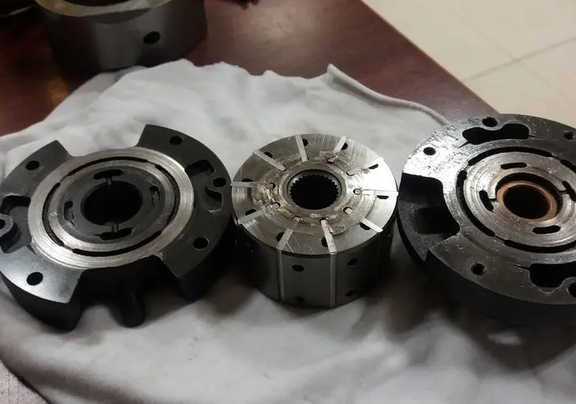The difference between gear pump and vane pump
There are significant differences between gear pumps and vane pumps in many aspects, including working principles, design features, performance and application areas.
1. Working principle
Gear pump: The working principle of the gear pump is to rely on a pair of meshing gears with the same number of teeth, equal width and module. When the gear rotates, the gear meshing and disengagement are used to form changes in the sealing volume to suck and press oil. Specifically, when the two gears mesh with each other, the liquid in the tooth pit is squeezed out to form a high-pressure space. At the same time, the closed space gradually increases, forming a negative pressure area. The inlet liquid is forced to flow into the suction of the pump under the action of atmospheric pressure. mouth.
Vane pump: The working principle of a vane pump is composed of rotor, stator, blades, distribution plate and end cover and other components. The blades can slide flexibly in the slots of the rotor. Under the action of the centrifugal force when the rotor rotates and the pressure oil flowing into the roots of the blades, the tops of the blades are close to the surface of the stator, forming a sealed working cavity. When the rotor rotates, the blades on one side extend outward, and the volume of the sealed working chamber gradually increases, creating a vacuum, so the oil is sucked in through the oil suction port and the upper window of the distribution plate; on the other side, the blades retract inward to seal the cavity. The volume gradually shrinks, and the oil in the seal cavity is forced out to the other window and the pressure port of the valve plate and sent to the system.

2. Design features
Gear pump: relatively simple design, solid structure, good self-priming ability, stable outlet flow, and reliable operation. However, it is sensitive to fluid contamination, may produce noise and vibration, and is not suitable for high-pressure applications.
Vane pump: Relatively complex design, but achieves high volumetric efficiency, has low noise levels, is suitable for medium pressure applications, and can handle light to medium viscosity fluids. However, its cost is higher and its maintenance requirements are relatively high.
3. Performance
Gear Pumps: Typically have high volumetric efficiencies but may not have high rated operating pressures due to leakage issues. Their efficiency range is typically between 85% and 95%.
Vane pumps: also have good volumetric efficiencies, usually in the range of 85% to 90%, and can remain efficient under various operating pressures. Its flow and pressure adjustment are relatively flexible.
4. Application areas
Gear pump: Due to its simple structure, low cost and easy maintenance, it is widely used in low to medium pressure situations where precise control of flow and pressure are not required, such as agricultural irrigation, oil exploration and other fields.
Vane pump: Due to its superior performance and adaptability to a variety of working conditions, it is more suitable for medium-pressure applications that require low noise and precise control, such as machine tools, ships, engineering machinery and other fields.




